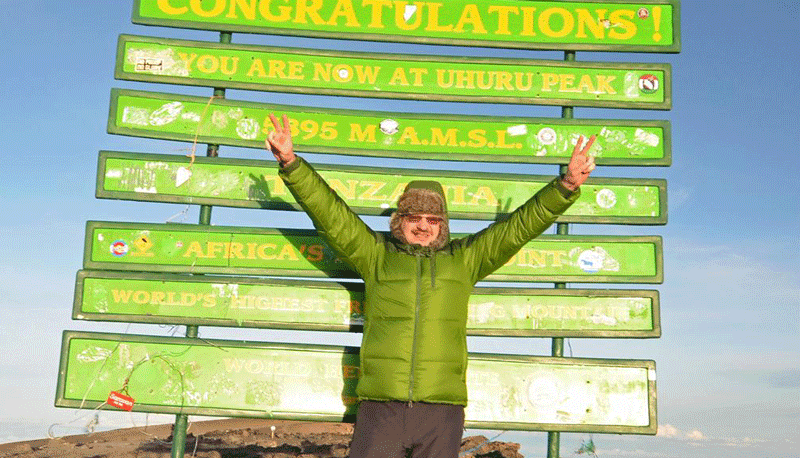Father Arthur conquers Mount Kilimanjaro
by Peter Jakey–Managing Editor
With prayers from his church and support from well-wishers in Rogers City and Posen, the Rev. Arthur Duchnowicz completed a grueling trek to the top of Mount Kilimanjaro with a new respect for the highest freestanding mountain.
Before leaving, he commented that the Mount Kilimanjaro climb would be a “relatively easy climb,” in terms of not needing specialized equipment to get to the summit.
“I definitely changed my mind,” said Duchnowicz, back in the quiet of his office at St. Ignatius Catholic Church. “It was a difficult thing.” The spiritual leader was telling parishioners it was the toughest physical experience of his life.
“It may be relatively easy when you compare it to Mount Everest, or some other technical mountains, but it is high enough and cold enough that it gets to everybody,” he said.
It’s a battle inside and out. The cold and wind wear down the outer parts of the body, while altitude sickness takes its toll on the inside.
Duchnowicz ascended with an international group of 10, which included climbers from Germany, the U.S. and Canada. Only one person, an American woman, would drop out, not very far from the summit.
ALL TRIPS to Uhuru Peak start in the forested slopes of Mount Kilimanjaro National Park. Climbers register at the gate of the park and begin.
A lot of ground was covered, before setting up for the night at the first camp. The first night was cold, below freezing, but each night would be colder than the previous.
The group, which included guides, porters and cooks, hiked six to seven hours the first two days, and seven to eight hours the next two. Most of the 29 porters would carry the tents and related equipment, plus the cooking supplies, food and water. They earn every bit of their pay.
Duchnowicz had to carry his daypack with his camera, water, boxed lunch, a raincoat, plus the St. Ignatius banner made by students from the school.
“The next day was a little bit steeper,” said Duchnowicz. They climbed to Shira camp the second day.
“Then landscape was one tree bent over, no leaves. Nothing else grows, it’s rock.”
On the third day, the group turns east and continue to climb “pole pole” (slowly, slowly), through increasingly rocky and barren terrain and continue their ascent to Lava Tower.
“The trek now starts to become more difficult, as the trail steepens and most hikers start to feel the effects of altitude sickness, such as weakness and lack of breath.”
From Lava Tower, they descended for two hours to take in the fantastic views, but more importantly, “You will also feel here the clear benefits of this acclimatization day, as we lose altitude down to the camp.”
THE NEXT day starts by taking on “the Great Barranco Wall,” and imposing face above the camp. “It was the steepest climb of the whole journey,” said Duchnowicz. “We went 90 minutes up.” The last camp before the final ascent was Barafu, a Swahili word for ice. The camping area is on a ridge in a narrow and exposed flat area. There were ever-present gale winds that come off the mountain peaks.
The climbers are told to rest for a few hours, because they would continue again at 11 p.m., so they could reach the summit by sunrise.
During these hours, Duchnowicz couldn’t sleep. “The wind was loud, but I had a lot of time to think about things. I prayed, and remembered all the support I had, the banner and encouragement from the kids,” he said. He also received an e-mail from Jerry Green, the St. Ignatius youth minister, reminding him that they were praying for a successful trip.
“I remembered that, and of course, the individual parishioners wishing me luck,” said Duchnowicz.
On that final day, Duchnowicz’s oxygen level wasn’t normal, and had him somewhat concerned about continuing, but he was told, if he was feeling good, to continue.
After a warm drink and a light snack, they started the final trek to the top of Africa.
AFTER APPROXIMATELY six hours of slow but strenuous hiking, they reached the rim of the main crater, Stella Point. From here, the hike to the peak isn’t as difficult. It’s another 45 minutes to an hour.
While a great moment in Duchnowicz’s life, the cold made it a short 10 minute stay. Many of the climbers didn’t want to take their cameras out for long because their hands were too cold.
“I had my hand out of my gloves, and I thought after a few moments that my fingers were going to be frozen,” said Duchnowicz. “One fellow was going to take a 10-minutes video and didn’t, and I had this idea of taking a banner out, but at the time, I wasn’t thinking about it. When I did, the guide told us we had to go. I didn’t have anybody there to take a pict
The trek down provided different challenges, such as pressure on the feet, which gave several blisters on the priest’s feet. He also may lose a few toenails.
Duchnowicz received a summit certificate at the end of the trail. “It was an incredible experience,” he said.
That was only part of the trip, which continued the next week at national parks in Tanzania, including a Serengeti safari.
Back home, he thanked local parishioners for their support and prayers. “A lot of people were happy to see me back in one piece, no broken bones or anything,” he said.
Now that he’s been to the top of Africa, what about the top of the world: Mount Everest. He’s done a little research about a possible climb, but a professional guide would cost about $70,000. He said that’s a little out of reach. Plus, one of 15 dies. “I don’t think it will happen,” said Duchnowicz. “I don’t have an ambition to climb Mt. Everest. Others (mountains), maybe.”

